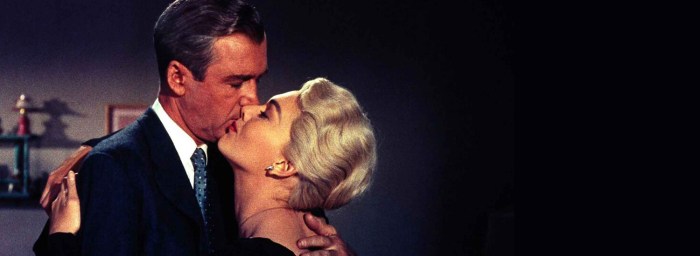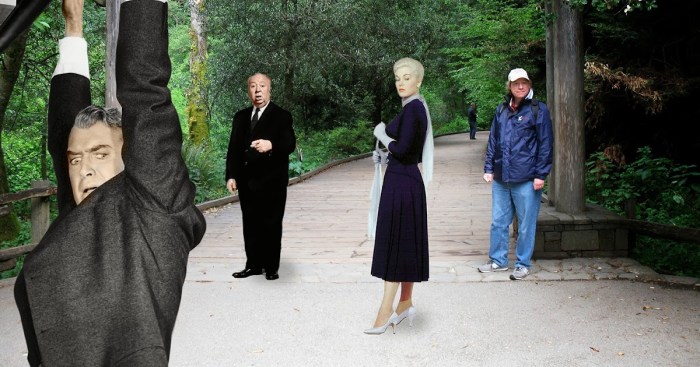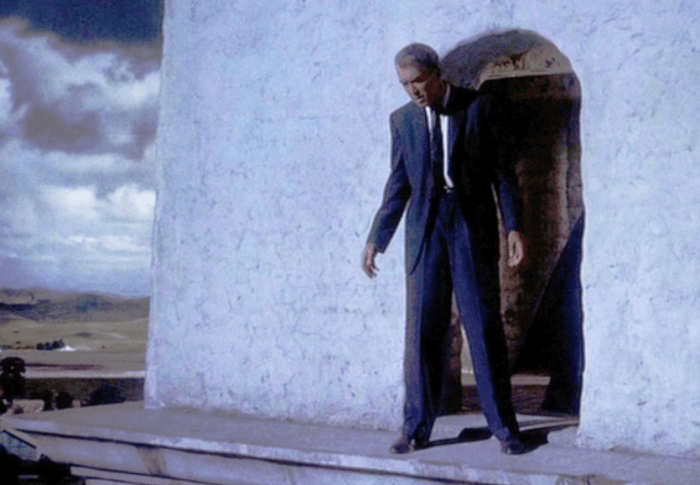Final scene in vertigo locale – The final scene in Vertigo, Alfred Hitchcock’s iconic masterpiece, is a cinematic tour de force that has captivated audiences for generations. Set amidst the haunting beauty of San Francisco’s Mission District, this climactic moment is a symphony of visual and emotional storytelling, leaving an unforgettable mark on viewers.
As the film reaches its crescendo, the scene unfolds on the vertiginous heights of a bell tower, where Detective Scottie Ferguson confronts his nemesis, the enigmatic Madeleine Elster. The tension is palpable, the atmosphere thick with suspense and foreboding.
Setting and Atmosphere: Final Scene In Vertigo Locale
The final scene of Vertigotakes place at the Mission San Juan Bautista, a historic Spanish mission located in the town of San Juan Bautista, California. The mission’s exterior serves as the backdrop for the climactic confrontation between Scottie Ferguson and Madeleine Elster.
The lighting in this scene is dim and overcast, casting an eerie and ominous atmosphere. The color scheme is dominated by shades of gray, brown, and green, creating a sense of decay and desolation. The overall ambiance is one of tension and suspense, as Scottie confronts his demons and the truth about Madeleine’s past.
Lighting and Color Scheme
The dim lighting and overcast sky create a sense of claustrophobia and entrapment, reflecting Scottie’s psychological state. The use of gray, brown, and green hues evokes a feeling of decay and neglect, symbolizing the crumbling of Scottie’s world and the unraveling of his sanity.
The final scene in Vertigo’s locale of San Francisco, with its iconic bell tower, is a haunting and unforgettable moment in cinema history. Like the acid in good fats , it lingers in the mind long after the credits have rolled, a testament to the power of film to evoke emotion and create lasting impressions.
Ambiance
The overall ambiance of the final scene is one of tension and suspense. The eerie lighting and desolate setting create a sense of foreboding, hinting at the impending tragedy. The silence is broken only by the sound of Scottie’s footsteps and the creaking of the mission’s wooden beams, adding to the atmosphere of unease and uncertainty.
Character Interactions

The final scene of Vertigo brings together a small but pivotal cast of characters, each with their own motivations and relationships that drive the plot and create dramatic tension.
Scottie Ferguson
- A retired police detective haunted by his past
- Initially hired to follow Madeleine Elster, he becomes obsessed with her
- His obsession leads him to believe that Judy Barton is Madeleine reincarnated
Judy Barton
- A woman who resembles Madeleine Elster
- Hired by Gavin Elster to impersonate Madeleine
- Falls in love with Scottie, but her true identity is eventually revealed
Gavin Elster
- Madeleine’s husband
- Hired Scottie to follow Madeleine, suspecting her of infidelity
- Reveals that he murdered Madeleine and framed Scottie for her death
Midge Wood
- Scottie’s friend and confidante
- Provides emotional support and helps Scottie unravel the mystery
- Uncovers Gavin’s true nature and helps Scottie confront him
The interactions between these characters create a complex web of relationships that drive the plot and create dramatic tension:
- Scottie’s obsession with Madeleine/Judy leads him to make reckless decisions that ultimately put him in danger.
- Judy’s love for Scottie forces her to confront her own identity and the consequences of her actions.
- Gavin’s manipulative and deceptive nature drives the plot forward, creating a sense of suspense and uncertainty.
- Midge’s unwavering support for Scottie provides a counterbalance to the darkness that surrounds him.
Symbolism and Imagery

The final scene of Vertigo is a masterpiece of cinematic symbolism and imagery, where every element contributes to the film’s profound themes and emotions.
The recurring spiral motif symbolizes the protagonist Scottie’s descent into obsession and madness. The iconic shot of Scottie looking down the vertiginous bell tower staircase represents his psychological vertigo, his loss of control over his own mind and reality.
Colors
The film’s color palette is carefully orchestrated to evoke Scottie’s emotional state. The use of cool, muted tones, such as blue and green, reflects his detachment and emotional numbness. In contrast, the flashes of vibrant red, as in the scenes involving Madeleine, symbolize passion, danger, and the intensity of his obsession.
Mirrors and Reflections
Mirrors and reflections are prevalent throughout the scene, symbolizing Scottie’s fragmented and distorted perception of reality. The mirror in Madeleine’s apartment, where Scottie sees her “transform” into Carlotta, represents his inability to separate fantasy from truth. The recurring motif of Scottie looking into mirrors also suggests his self-absorption and his search for his own identity.
Height and Vertigo
The film’s title, Vertigo, is not only a reference to Scottie’s physical condition but also a metaphor for his psychological state. The constant shots of high places and the feeling of vertigo symbolize his emotional instability and the precariousness of his grip on reality.
The Green Dress
The green dress worn by both Madeleine and Carlotta is a powerful symbol of Scottie’s obsession. The color green represents both envy and growth, suggesting Scottie’s desire to possess Madeleine and his own personal transformation through his experiences.
The Bell Tower
The bell tower, where the final confrontation takes place, is a symbol of both Scottie’s triumph and his downfall. His ascent to the top of the tower represents his confrontation with his fears and his desire for closure. However, the tower’s crumbling state also foreshadows his ultimate collapse and the shattering of his illusions.
Camera Techniques

The final scene of Vertigois a masterpiece of cinematic technique. The camera angles, movements, and framing are used to create a sense of suspense, drama, and unease.
Camera Angles
The scene opens with a high-angle shot of Scottie and Madeleine standing on the roof of the tower. This shot makes the characters seem small and vulnerable, and it creates a sense of foreboding.
Camera Movements
The camera then follows Scottie as he climbs the stairs to the top of the tower. The camera’s movement is slow and deliberate, which builds tension and suspense.
Framing
The scene is often framed in such a way that Scottie and Madeleine are separated by the bars of the tower. This framing creates a sense of distance between the characters, and it suggests that they are trapped in their own worlds.
Sound and Music

The final scene of Vertigo masterfully employs sound effects and music to create an immersive and emotionally charged atmosphere. These elements contribute significantly to the film’s narrative, enhancing the tension, suspense, and emotional impact of the climax.
Sound Effects
- Creaking Floorboards:The creaking of the floorboards in the tower adds to the sense of unease and anticipation. It serves as a constant reminder of the precariousness of Scottie’s situation and the danger that lurks around every corner.
- Wind Howling:The howling wind outside the tower amplifies the feeling of isolation and vulnerability. It creates a sense of urgency, as if time is running out for Scottie to save Madeleine.
- Footsteps:The sound of footsteps approaching from behind heightens the tension and suspense. It suggests the presence of an unseen threat, keeping the audience on the edge of their seats.
Music
- Bernard Herrmann’s Score:Herrmann’s iconic score plays a crucial role in creating the film’s atmosphere. The haunting and disorienting melodies reflect Scottie’s inner turmoil and the unsettling nature of his obsession.
- “The Vertigo Theme”:This recurring motif symbolizes Scottie’s descent into madness. It plays during key moments of the film, reinforcing the themes of obsession, vertigo, and the blurring of reality.
- Silence:The sudden absence of music in certain moments amplifies the emotional impact. The silence creates a sense of anticipation and dread, allowing the audience to fully absorb the gravity of the situation.
Editing and Pacing

The final scene of Vertigo masterfully employs editing techniques and pacing to evoke a profound emotional impact on the audience. The seamless transitions and rhythmic flow of the editing contribute significantly to the film’s overall cinematic experience.
Editing Techniques
- Jump cuts:Abrupt cuts between shots create a sense of disorientation and heighten the intensity of the climactic confrontation.
- Cross-cutting:Intercutting between Scottie and Judy’s perspectives intensifies the suspense and emotional stakes.
- Slow motion:Key moments, such as Scottie’s plunge from the tower, are slowed down to emphasize their dramatic weight.
Pacing and Rhythm
The editing pace accelerates as the scene progresses, mirroring Scottie’s escalating emotions. Slow-paced moments of contemplation contrast with rapid-fire cuts during the climactic confrontation, creating a heightened sense of tension and urgency.
Significance of Editing, Final scene in vertigo locale
The editing in the final scene of Vertigo plays a crucial role in shaping the audience’s experience. It heightens the emotional impact, creates a sense of suspense and urgency, and guides the viewer’s interpretation of the film’s themes and characters.
Cultural and Historical Context

The final scene of Vertigo is set in the context of post-World War II San Francisco, a time of significant social and cultural change. The city was a hub for returning veterans, many of whom were struggling to readjust to civilian life.
The scene reflects the prevailing values of the era, including a fascination with the past, a search for meaning in a rapidly changing world, and a desire for escape.
Impact of Cultural and Historical Factors
The scene’s depiction of Scottie’s obsession with Madeleine reflects the postwar fascination with the past and the desire to recapture lost time. The character’s inability to move on from his memories of Madeleine parallels the nation’s struggle to come to terms with the horrors of war.The
film’s exploration of identity and perception also reflects the cultural and historical context of the time. In the postwar era, many people were questioning their own identities and searching for meaning in a world that seemed increasingly complex and uncertain.
The scene’s use of mirrors and reflections symbolizes this search for identity and the difficulty of distinguishing between reality and illusion.
Comparison to Other Scenes
The final scene of Vertigostands as a culmination of the film’s themes and narrative, echoing and contrasting with key scenes throughout the film.
The Dream Sequence
The final scene parallels the dream sequence in the Mission San Juan Bautista, where Scottie first sees Madeleine and falls in love with her image. Both scenes involve Scottie’s desire for an idealized woman, but the final scene reveals the tragic consequences of his obsession.
The Car Chase
The final scene also contrasts with the intense car chase sequence on Lombard Street. While the car chase represents Scottie’s pursuit of Madeleine, the final scene shows the destructive nature of his obsession and the ultimate failure of his pursuit.
The Golden Gate Bridge
The Golden Gate Bridge serves as a recurring symbol throughout the film, representing both Scottie’s desire for Madeleine and his eventual downfall. In the final scene, Scottie’s confrontation with Judy on the bridge symbolizes his confrontation with the truth and his acceptance of his own complicity in Madeleine’s death.
Significance of the Final Scene
The final scene of Vertigoserves as a powerful resolution to the film’s themes of obsession, guilt, and the search for identity. It brings together the various threads of the narrative and provides a cathartic conclusion to Scottie’s journey.
Popular Questions
What is the significance of the bell tower setting in the final scene?
The bell tower represents Scottie’s inner turmoil and the height of his obsession with Madeleine. It is a place of both danger and revelation, where he must confront his own demons.
How does the use of color contribute to the atmosphere of the final scene?
The muted colors and chiaroscuro lighting create a sense of unease and uncertainty, reflecting the characters’ emotional states.
What is the role of sound in enhancing the tension in the final scene?
The eerie sound effects, including the tolling of the bells and Madeleine’s screams, heighten the sense of suspense and create a palpable sense of dread.